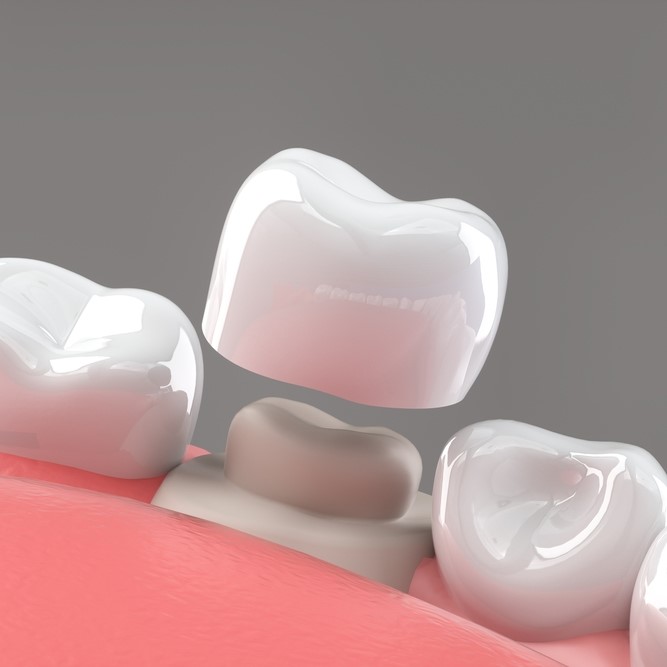Transform Your Smile Seamlessly With
Ceramic Braces in Riyadh
Clear Choice for Straight Teeth!
Read in Arabic ( الأقواس الخزفية )
Are you self-conscious about your smile but hesitant to get traditional metal braces? If so, ceramic braces may be the solution you’re looking for. With their clear or tooth-colored brackets, ceramic braces provide a more discreet option for straightening your teeth. In this article, we’ll explore everything you need to know about ceramic braces, from how they work to the cost and aftercare involved. So, whether you’re a teenager or an adult looking to improve your smile, read on to discover the benefits of ceramic braces in Riyadh.
Procedure Time
1 - 2 Hours
Downtime
2 - 3 Days
Back to Work
1 - 2 Days
Results
1 - 3 Years
What Are Ceramic Braces?
Ceramic braces are a type of orthodontic braces that are used to straighten crooked teeth and fix bite problems. They are similar to traditional metal braces, but instead of metal brackets and wires, they use clear or tooth-colored brackets and wires that blend in with your teeth.
Ceramic braces require the same level of care as traditional metal braces, such as regular brushing and flossing, and adjustments by an orthodontist every few weeks. They may be slightly more fragile than metal braces, so it’s important to be careful when eating hard or sticky foods.
Overall, ceramic braces can be a great option for people who want a more subtle option for straightening their teeth. If you’re considering orthodontic treatment, be sure to talk to your dentist or orthodontist to see if ceramic braces are a good option for you.
Who Needs Ceramic Braces?
Ceramic braces can be a good option for anyone who needs orthodontic treatment to straighten their teeth or correct their bite, but who wants a more discreet option than traditional metal braces. They are particularly popular among adults and older teenagers who may be self-conscious about the appearance of metal braces.
Ceramic braces can be used to treat a wide range of dental issues, including:
- Crooked or misaligned teeth
- Overcrowding
- Overbite or underbite
- Crossbite
- Open bite
- Gaps between teeth
However, ceramic braces may not be suitable for everyone. Your orthodontist will be able to advise you on the best treatment option for your specific needs and circumstances.
Ceramic Braces Before and After
Here you can clearly see the before and after difference of ceramic braces.If you want to know more, get yourself a free consultation now at Enfield Royal Saudia.

Benefits of Ceramic Braces
Here are some benefits of ceramic braces in simple bullet points:
- Less noticeable than traditional metal braces.
- Comfortable to wear.
- Durable and can withstand the forces of orthodontic treatment.
- Effective at straightening crooked teeth and correcting bite problems.
- Predictable outcomes for a personalized treatment plan.
Ceramic Braces vs Metal Braces
Ceramic braces and metal braces are both orthodontic treatment options used to straighten teeth and correct bite problems. However, there are some differences between the two:
Ceramic Braces
- Less noticeable than metal braces
- Made of clear or tooth-colored brackets and wires that blend in with teeth
- May be more fragile than metal braces and require careful eating habits
- Slightly more expensive than metal braces
- Treatment time may be longer compared to metal braces
Metal Braces
- More noticeable than ceramic braces
- Made of metal brackets and wires.
- Strong and durable, able to withstand eating hard or sticky foods.
- Generally less expensive than ceramic braces.
- Treatment time may be shorter compared to ceramic braces
Ultimately, the choice between ceramic braces and metal braces comes down to personal preference and the specific needs of each individual patient. Your orthodontist will be able to advise you on the best treatment option for your specific case.
Procedure of Ceramic Braces

The process of getting ceramic braces is similar to that of traditional metal braces. Here are the main steps:
Consultation
The first step is to schedule a consultation with an orthodontist to determine if ceramic braces are a good option for you. During this appointment, the orthodontist will examine your teeth, take X-rays and impressions, and discuss your treatment options.
Placement
If you decide to go ahead with ceramic braces, the orthodontist will begin the process of placing them on your teeth. This involves cleaning and preparing the teeth, applying a special adhesive, and attaching the clear or tooth-colored brackets to your teeth. The orthodontist will then thread a thin wire through the brackets and secure it with elastic bands.
Adjustments
Over the course of your treatment, you will need to visit your orthodontist regularly to have your braces adjusted. During these appointments, the orthodontist will tighten the wire to gradually move your teeth into the correct position. They may also change the elastic bands that hold the wire in place.After the incisions are done, the skin that is still intact between the nose lifts and is easily removed.
Maintenance
It’s important to take good care of your ceramic braces during treatment to ensure the best possible outcome. This includes brushing and flossing regularly, avoiding hard and sticky foods that could damage your braces, and wearing any additional appliances or accessories prescribed by your orthodontist.
Removal
Once your treatment is complete, your orthodontist will remove your ceramic braces. This is a quick and painless process, and your orthodontist may recommend a retainer to help maintain your newly straightened teeth.
Overall, the process of getting ceramic braces is straightforward and typically takes between 18-24 months, depending on the severity of your case. Your orthodontist will be with you every step of the way to ensure the best possible outcome.
Aftercare of Ceramic Braces
Aftercare for ceramic braces is important to ensure that they work properly and to maintain good oral hygiene during and after treatment. Here are some tips for caring for your ceramic braces:
- Brush and floss regularly: It’s important to brush your teeth at least twice a day, and floss once a day to remove any food particles or plaque that may have become stuck around your braces.
- Avoid hard or sticky foods: Hard and sticky foods, such as popcorn, chewing gum, and hard candy, can damage your ceramic braces. Stick to soft foods, such as cooked vegetables, pasta, and fish.
- Wear a mouthguard during physical activity: If you play sports or engage in other physical activities, it’s important to wear a mouthguard to protect your braces and teeth from damage.
- Attend regular check-ups: You will need to attend regular check-ups with your orthodontist to ensure that your braces are working properly and to make any necessary adjustments.
- Be mindful of staining: Ceramic braces can become stained over time from certain foods and drinks, such as coffee, tea, and red wine. Try to avoid these types of foods and drinks, or brush your teeth after consuming them to minimize staining.
- Follow your orthodontist’s instructions: Your orthodontist will provide you with specific instructions on how to care for your ceramic braces. It’s important to follow these instructions carefully to ensure the best possible outcome.
By following these aftercare tips, you can help to ensure that your ceramic braces work effectively and that you maintain good oral hygiene during and after treatment.
What is the Recovery Time of Ceramic Braces?
There is typically no recovery time required for ceramic braces. While you may experience some discomfort or soreness after the braces are first applied or adjusted, this should subside within a few days. You should be able to resume normal activities, including eating and speaking, immediately after getting ceramic braces. However, it’s important to follow your orthodontist’s instructions for care and maintenance of your braces to ensure that they work properly and that your treatment is successful.
Cost of Ceramic Braces in Riyadh
The cost of ceramic braces in riyadh, KSA can vary depending on several factors, such as the severity of your dental issues, the length of your treatment, and the specific orthodontic practice you choose.
It’s best to consult with a local orthodontist in Riyadh for an accurate estimate of the cost of ceramic braces. They can provide you with specific information on the fees involved and any payment plans or financing options that may be available to you.
Why Choose Us?
At Enfield Royal Clinic, we pride ourselves on providing top-quality orthodontic care to our patients. Here are a few reasons why you should choose us for your ceramic braces treatment:
Our team of orthodontists has extensive experience and training in the latest techniques and technologies used in orthodontic treatment, including ceramic braces.
We understand that every patient has unique dental needs and goals, which is why we create personalized treatment plans tailored to your individual situation.
Secure Your Spot: Book an Appointment Today!
By choosing Enfield Royal Clinic for your ceramic braces treatment, you can be confident that you are receiving the highest standard of care. We invite you to book an appointment with us and see for yourself why we are the top choice for orthodontic care in the area.
FAQs.
The length of treatment with ceramic braces varies depending on the severity of your dental issues and the specific treatment plan created by your orthodontist. On average, treatment with ceramic braces can take between 18 and 36 months.
Ceramic braces are generally more expensive than metal braces because they are made from more expensive materials. However, the exact cost of treatment will depend on a variety of factors, including your individual needs and the orthodontic practice you choose.
While ceramic braces don’t require special care, they do require regular brushing and flossing to keep them clean and avoid staining. Your orthodontist may also recommend using a mouthwash or fluoride treatment to keep your teeth healthy during treatment.
Relevant Treatments.

Dental Braces
Does smiling in front of people make you conscious? Do you feel bad in a room full of people? Do you also want perfect teeth and a beautiful smile? Well, no need to worry. Dental braces are the ultimate solution for your problem.With the help of dental braces, you will...

Dental Crowns
An injured or rotting tooth may be saved by a dental crown, which will restore both its appearance and function. A dental crown must be positioned precisely and expertly, though. The establishment of a strong bond between the crown and the tooth is an essential phase in this...
Relevant Posts.

Ceramic Braces Cost in Riyadh
Embrace the way to get a flawless smile without compromising your appearance. Do not let your teeth hold you back in your squad, join us to explore the countless transformations to your smile with our inexpensive dentist care. Reveal your glowing smile with Ceramic Braces Cost in Riyadh! Say goodbye to self-consciousness and welcome confidence with our continuous and influential braces. Our clinic offers you the perfect combination of styles and performance to design straight teeth. Come forward and visit our clinic today and get more details about braces.




